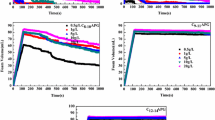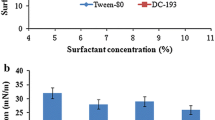Abstract
The influence of surfactant structure on foam properties of internal olefin sulfonate (IOS) and alpha olefin sulfonate (AOS) in aqueous solutions was estimated from measurements of the foamability, foam stability, and foam morphology, as obtained from conductivity and image analyses techniques. It was found that the foamability and foam stability of C16–18 AOS are higher compared to that of C16–18 IOS, indicating that hydrocarbon chain branching decreases the foamability and foam stability. The foamability and foam stability are enhanced with increasing surfactant concentration, which increases the adsorbed quantity of surfactant molecules at the air–water interface. The influence of hydrocarbon chain branching on foam morphology was also investigated. It was found that foam cells produced by branched chain C16–18 IOS are larger than the foam cells generated by straight chain C16–18 AOS.








Similar content being viewed by others
References
Exerowa D, Kruglyakov PM (1997) Foam and foam films: theory, experiment, application. Elsevier, London
Wang J, Nguyen AV, Farrokhpay S (2016) A critical review of the growth, drainage and collapse of foams. Adv Colloid Interface Sci 228:55–70
Schelero N, Hedicke G, Linse P (2010) Effects of countries and co-ions on foam films stabilized by anionic dodecyl sulfate. J Phys Chem B 114:15523–15529
Wu X, Zhao J, Li E (2011) Interfacial dilational viscoelasticity and foam stability in quaternary ammonium gemini surfactant systems: influence of intermoleculare hydrogen bonding. Colloid Polym Sci 289:1025–1034
Wang J, Liu H, Ning Z (2012) Experimental research and quantitative characterization of nitrogen foam blocking characteristics. Energy Fuels 26:5152–5163
Carey E, Stubenrauch C (2010) Foaming properties of mixtures of a non-ionic (C12DMPO) and an ionic surfactant (C12TAB). J Colloid Interface Sci 346:414–423
Hu X, Li Y, He X (2011) Structure-behavior-property relationship study of surfactants as foam stabilizers explored by experimental and molecular simulation approaches. J Phys Chem B 116:160–167
Wang XC, Zhang L, Gong QT (2009) Study on foaming properties and dynamic surface tension of sodium branched-alkyl benzene sulfonates. J Dispers Sci Technol 30:137–143
Wang XC, Zhang L, Gong QT (2009) A study of dynamic interfacial properties as related to foaming properties of 2,5-dialkyl benzene sulfonates. J Dispers Sci Technol 30:346–352
Beneventi D, Carre B, Gandini A (2001) Role of surfactant structure on surface and foaming properties. Colloid Surf A 189:65–73
Stubenrauch C, Khristov K (2005) Foams and foam films stabilized by CnTAB: influence of the chain length and of impurities. J Colloid Interface Sci 286:710–718
You Y, Wu X, Zhao J (2011) Effect of alkyl tail length of quaternary ammonium gemini surfactants on foaming properties. Colloid Surf A 384:164–171
Tan SN, Fornasiero D, Sedev R (2005) The role of surfactant structure on foam behavior. Colloid Surf A 263:233–238
Tamura T, Takeuchi Y, Kaneko Y (1998) Influence of surfactant structure on the drainage of nonionic surfactant foam films. Colloid Surf A 206:112–121
Carey E, Stubenrauch C (2009) Properties of aqueous foams stabilized by dodecyltrimethylammonium bromide. J Colloid Interface Sci 333:619–627
Lunkenheimer K, Malysa K (2003) A simple automated method of quantitative characterization of foam behaviour. Polym Int 52:536–547
Ropers MH, Novales B, Boué F (2008) Polysaccharide/surfactant complexes at the air-water interface-effect of the charge density on interfacial and foaming behaviors. Langmuir 24:12849–12857
Rami-Shojaei S, Vachier C, Schmitt C (2009) Automatic analysis of 2D foam sequences: application to the characterization of aqueous proteins foams stability. Image Vis Comput 27:609–622
Pugh RJ (1996) Foaming, foam films, antifoaming and defoaming. Adv Colloid Interface Sci 64:67–142
Zhang H, Xu G, Liu T (2013) Foam and interfacial properties of Tween 20–bovine serum albumin systems. Colloid Surf A 416:23–31
Rosen MJ, Kunjappu JT (2012) Surfactants and interfacial phenomena, 4th edn. Wiley, New York
Varadaraj R, Bock J, Zushma S (1992) Influence of hydrocarbon chain branching on interfacial properties of sodium dodecyl sulfate. Langmuir 81:14–17
Barik TK, Roy A (2009) Statistical distribution of bubble size in wet foam. Chem Eng Sci 64:2039–2043
Weaire D, Hutzler S (1998) Nonlinear phenomena in soap froth. Physcia A 257:264–274
Author information
Authors and Affiliations
Corresponding author
About this article
Cite this article
Wang, Y., Liu, X., Zhou, Y. et al. Influence of Hydrocarbon Chain Branching on Foam Properties of Olefin Sulfonate with FoamScan. J Surfact Deterg 19, 1215–1221 (2016). https://doi.org/10.1007/s11743-016-1872-1
Received:
Accepted:
Published:
Issue Date:
DOI: https://doi.org/10.1007/s11743-016-1872-1




